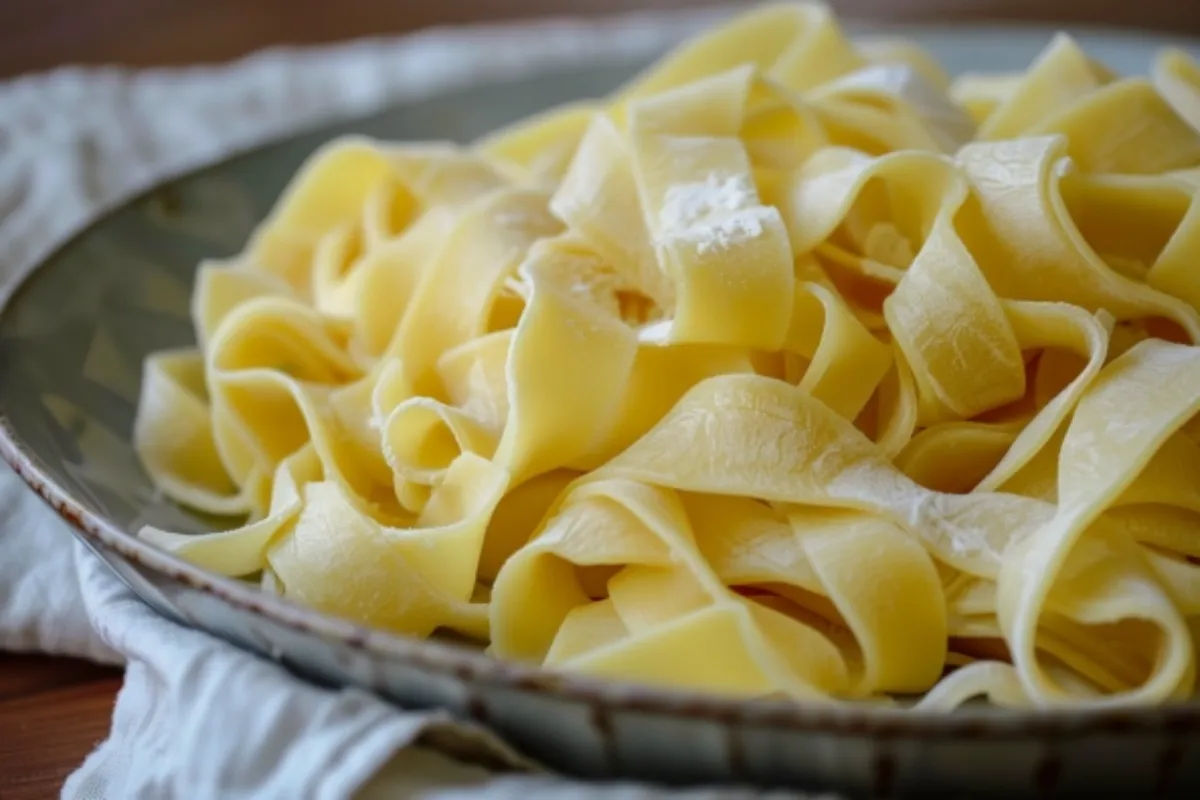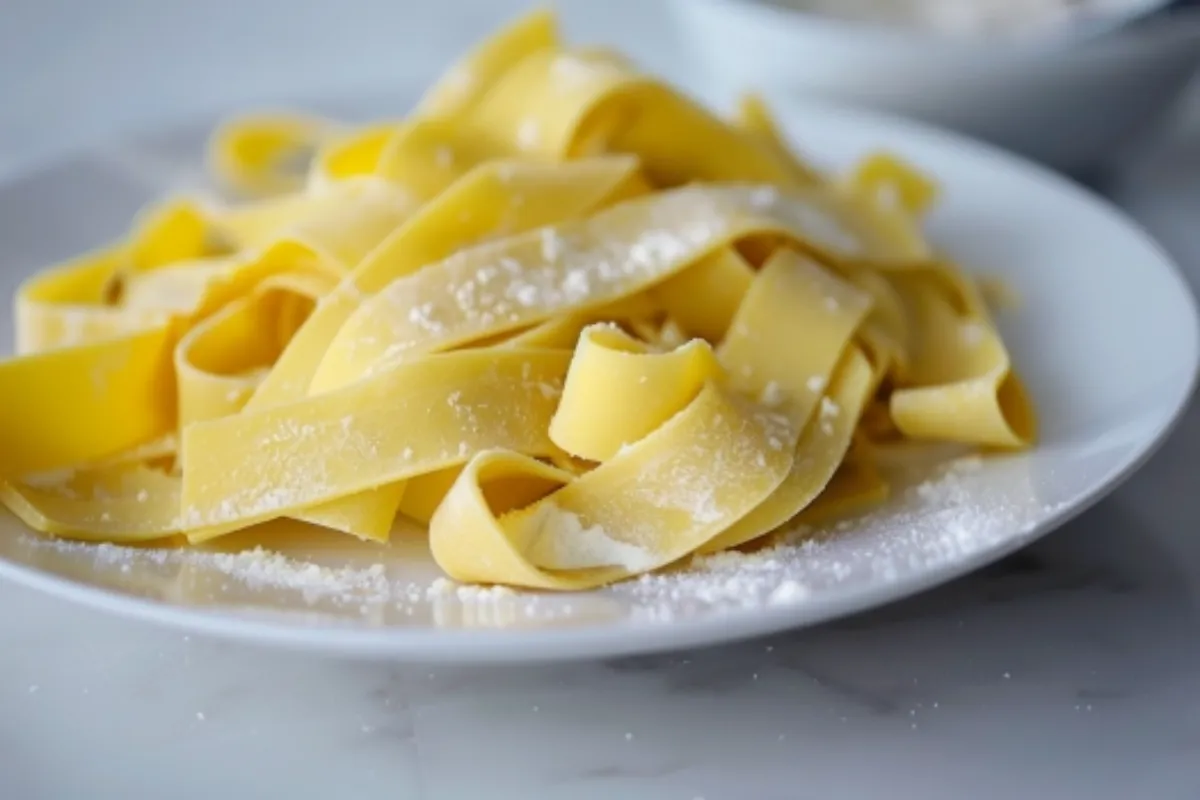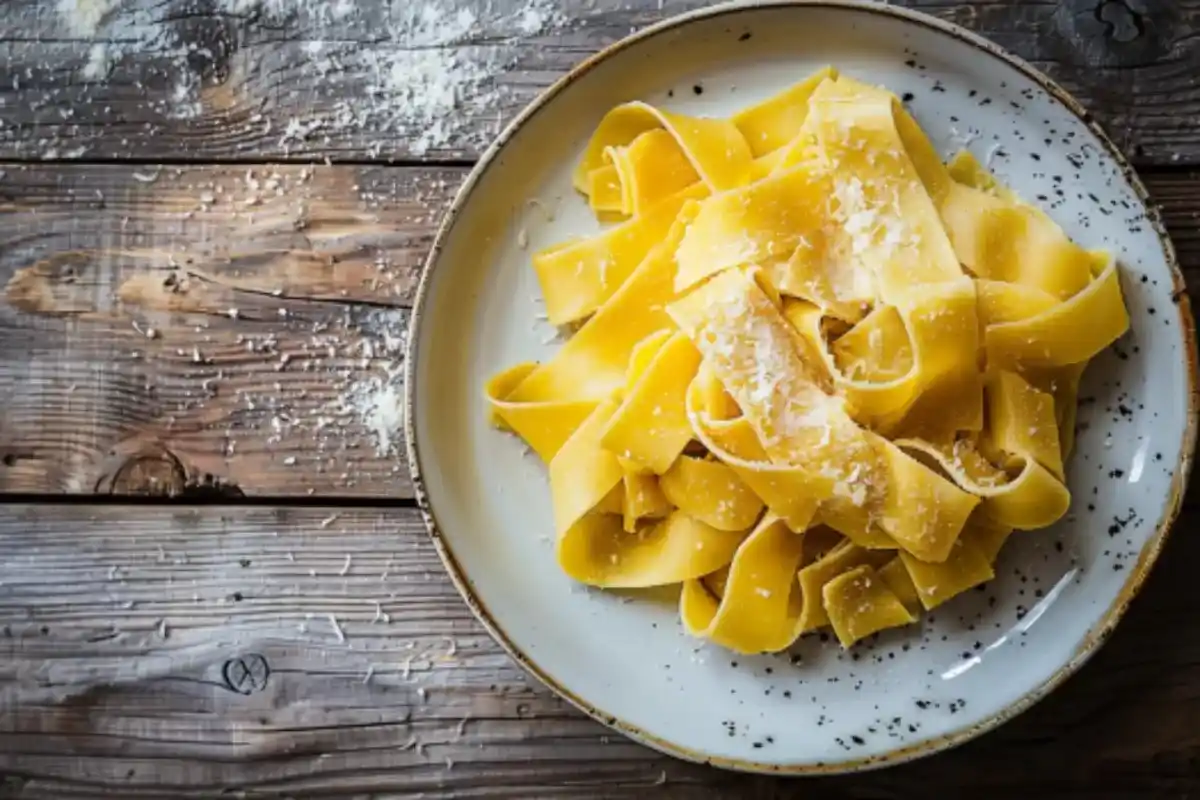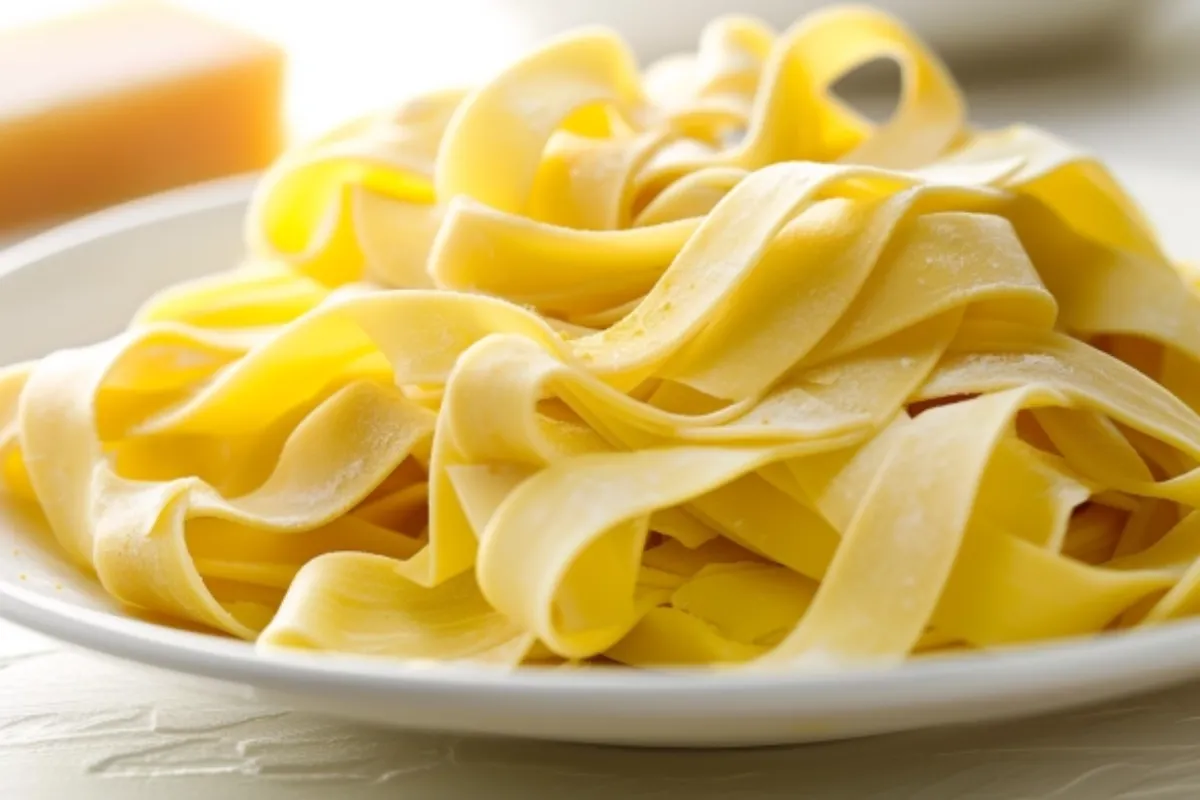Pappardelle is a broad, ribbon-like pasta that hails from Tuscany, Italy. It is known for its large surface area and hearty texture. Additionally, its very name is derived from the Italian verb “pappare,” which means “to gobble up.” This hints at its long-standing popularity as a comfort food in Italy. Furthermore, this pasta is perfect for rich sauces with thicker textures. For example, sauces like ragù cling well to the wide ribbons. But when it comes to how you eat pappardelle, especially in an elegant setting, it can be a bit tricky. Understanding how to eat pappardelle properly enhances your dining experience. Additionally, it ensures that you can fully appreciate the dish.
In this guide, we’ll walk you through not only how to enjoy pappardelle gracefully but also its origins, the best sauces to pair with it, and how to prepare it at home. By the end, you’ll have a deep appreciation for this ribbon-like pasta and feel confident in preparing and enjoying it.
What is Pappardelle?
At its core, pappardelle is a wide, flat noodle that is traditionally made from egg-based dough, though it can also be crafted from durum wheat semolina. It is usually about 1 to 1.5 inches in width, making it one of the broader forms of pasta. The texture of pappardelle is smooth and slightly elastic when cooked al dente. This term means “to the tooth” in Italian. It refers to the perfect state of doneness for pasta. Additionally, when cooked al dente, the pasta offers slight resistance to the bite. However, it is still fully cooked through.
Origins of Pappardelle and How It’s Traditionally Eaten

The name “pappardelle” is derived from the Italian word pappare, meaning to eat or gobble up quickly, which perfectly describes the experience of enjoying this pasta. Traditionally, pappardelle was served with wild boar ragù or rabbit ragù, both popular dishes in Tuscany. These meat-based ragùs were the perfect complement to the broad noodles, as their robust flavor profiles required a substantial pasta that could stand up to the richness of the sauce.
Today, pappardelle remains a staple in Italian cuisine, with both fresh and dried varieties available. Whether made by hand in a traditional Italian kitchen or purchased from a local gourmet shop, pappardelle is a versatile pasta that can be paired with a variety of sauces and ingredients. To explore different ways pappardelle is used in modern cooking, check out this guide to pappardelle pasta.
Texture and Shape of Pappardelle
The defining feature of pappardelle is its wide ribbons, which are capable of carrying heavier sauces that other pasta shapes might struggle with. The pasta’s texture is smooth yet firm when cooked properly, offering a satisfying mouthfeel. This is especially important when you eat pappardelle with thick, meaty sauces such as ragù, which clings to the broad surface of the pasta, delivering a perfect bite every time. The width of pappardelle also allows it to hold small chunks of meat, vegetables, or other additions, making each forkful a well-rounded experience when you eat pappardelle.
Pappardelle is often compared to similar pasta shapes like fettuccine or tagliatelle, both of which are also flat noodles but significantly narrower. While fettuccine and tagliatelle are excellent for lighter sauces such as Alfredo or carbonara, pappardelle is more suitable for robust, chunky sauces. Its broad surface area can hold more sauce per bite, creating a more flavorful and hearty experience.
- Fun Fact: The width of pappardelle can vary slightly depending on the region in Italy where it’s made. In Tuscany, the pasta is often slightly wider, reflecting the region’s preference for substantial, hearty dishes.
Sauce Pairings for Pappardelle: Why It Matters
Choosing the right sauce for pappardelle is essential. This is because the wide ribbons need a sauce that complements their texture and flavor. Due to its broad surface and slightly chewy texture, pappardelle pairs best with heavier sauces. These sauces stick to the noodles and provide a rich, savory bite. Classic meat sauces like ragù alla Bolognese or wild boar sauce are traditional choices. However, the versatility of pappardelle allows it to be paired with a variety of other sauces. Additionally, vegetarian options work well with this pasta.
Ragù Alla Bolognese
Ragù alla Bolognese is one of the most traditional pairings for pappardelle. This rich and hearty meat sauce is made with ground beef or veal, onions, celery, and carrots. Additionally, wine, tomatoes, and a touch of cream are added to create a complex and flavorful sauce. Moreover, this sauce clings beautifully to the wide noodles. The origins of ragù date back to the Emilia-Romagna region. In this region, slow-cooking meat in tomatoes and wine became a culinary tradition.
- Pro Tip: When pairing pappardelle with ragù alla Bolognese, make sure the pasta is cooked al dente to provide a satisfying contrast to the rich, velvety sauce. The sauce should cling to the pasta without being too soupy.
Mushroom and Truffle Oil: A Delicious Vegetarian Pairing for Pappardelle
For a more vegetarian-friendly option, pairing pappardelle with wild mushrooms and truffle oil is an elegant choice. The earthiness of the mushrooms complements the richness of the pasta, while the truffle oil adds a luxurious aroma and flavor. This pairing is popular in upscale Italian restaurants and is often served as a main course with a sprinkling of Parmesan cheese and fresh herbs. If you want to try your hand at this pairing, explore this recipe collection for pappardelle to get started.
- Variations: You can substitute truffle oil with other aromatic oils like rosemary or garlic oil for a different flavor profile, or even add sautéed spinach or kale for an added layer of texture.
How to Eat Pappardelle with Wild Game Sauces
Another traditional pairing for pappardelle is wild game ragù, typically made with wild boar, venison, or rabbit. These meats are slow-cooked with red wine, herbs, and tomatoes. This creates a deeply flavorful sauce that complements the pasta’s broad ribbons. Additionally, this dish is commonly found in Tuscan kitchens during the colder months. The robust flavors and heartiness of the sauce make it a perfect comfort food.
- Cooking Tip: If you’re making wild game ragù at home, it’s important to allow the meat to cook slowly over low heat to ensure it becomes tender and develops rich flavors. The red wine helps to deglaze the pan and add depth to the sauce.
Light Tomato-Based Sauces
While pappardelle is best known for being paired with rich meat sauces, it can also be enjoyed with lighter tomato-based sauces. Additionally, a simple sauce made from ripe tomatoes, garlic, and basil can be a great option. Moreover, a drizzle of olive oil adds a refreshing touch. This lighter sauce can be a nice change of pace from the heavier options. This type of sauce allows the flavor of the pasta to shine through while still providing a satisfying meal.
- Serving Suggestion: When serving pappardelle with a lighter sauce, consider adding a protein such as grilled chicken or shrimp for a more balanced dish. You can also toss in fresh vegetables like zucchini or bell peppers for added color and texture.
- Pro Tip: If you prefer something simple but flavorful, try tossing pappardelle in a light tomato sauce and garnishing it with fresh herbs and Parmesan. This approach allows the pasta itself to be the star of the dish, with the sauce serving as a complementary accent.
How to Properly Eat Pappardelle Like an Italian

While eating pappardelle, technique is everything. Due to its width and slightly chewy texture, pappardelle can be more challenging to eat. In contrast, thinner pastas like spaghetti or linguine are easier to manage. However, with a bit of practice, you can enjoy this pasta more easily. Additionally, you can avoid making a mess or losing any of the sauce in the process.
Traditional Italian Etiquette for Eating Pappardelle
In Italy, pasta is often eaten with just a fork, and pappardelle is no exception. The wide ribbons of pappardelle make it difficult to twirl like spaghetti, so the key is to gather a small section of the pasta onto your fork and take controlled bites. Cutting the pasta with a knife is generally discouraged, as it disrupts the texture and experience of eating the ribbons.
- Twirl the noodles carefully: Use your fork to gather a small portion of pappardelle onto the tines, twirling it against the plate rather than using a spoon.
- Keep the sauce in control: Make sure the pasta is well-coated with sauce but not dripping, which will help you avoid splattering when you take a bite.
- Take manageable bites: Pappardelle’s wide ribbons make it important to avoid overloading your fork. Taking smaller, more controlled bites will ensure you enjoy the flavors without making a mess.
For more tips on how to elevate your pasta experience, check out this guide on jazzing up boring pasta.
How to Eat Pappardelle Gracefully: Step-by-Step Guide
- Twirl and gather: Start by twirling a small section of pasta onto your fork. Avoid overloading your fork, as pappardelle’s wide ribbons can be difficult to manage in large portions.
- Control the sauce: Make sure the pasta is evenly coated with sauce to prevent any from slipping off when you take a bite. A well-balanced twirl will keep the sauce clinging to the pasta and prevent unnecessary splattering.
- Take small bites: Since pappardelle is wider than other pastas, taking smaller bites helps maintain etiquette and prevents you from overwhelming your mouth with too much pasta at once.
- Savor each bite: Pappardelle is meant to be enjoyed slowly, allowing the flavors of the sauce and pasta to meld together. Take your time to savor the richness of the dish and appreciate the texture of the pasta.
If you’re looking to explore more about how different types of pasta compare and how they’re best enjoyed, you can explore this guide on spiral pasta types.
Fork vs. Spoon: The Best Tools for Eating Pappardelle
The question of whether to use a fork alone or a fork and spoon together when eating pappardelle is one of the most debated topics among pasta lovers. In most traditional Italian settings, a fork alone is considered the proper tool for eating pasta, including pappardelle. The idea is to twirl the pasta against the plate to gather it into a manageable bite without the need for a spoon.
However, some people prefer to use a spoon as an aid when twirling the pasta, especially for wider noodles like pappardelle. The spoon acts as a stabilizer, allowing you to twirl the pasta neatly without the ribbons slipping off the fork. While this method can be helpful, especially for beginners, it is often seen as less traditional in Italian culture.
- Pro Tip: If you’re dining in a formal Italian setting, it’s best to stick with just a fork when eating pappardelle. In more casual settings, feel free to use a spoon if it helps you manage the wide ribbons more easily.
Popular Pappardelle Dishes and How to Enjoy Them
Pappardelle is incredibly versatile and can be used in a variety of dishes that range from rich meat-based sauces to lighter vegetarian options. Some of the most popular dishes featuring pappardelle include:
Pappardelle al Ragù: The Classic Way to Eat Pappardelle
This is perhaps the most iconic dish made with pappardelle. The slow-cooked meat sauce, typically made with beef or pork, is simmered for hours until it becomes rich and velvety. The wide ribbons of pappardelle are the perfect vehicle for this hearty sauce, ensuring that every bite is packed with flavor. Ragù al cinghiale, or wild boar ragù, is another traditional version of this dish that is popular in Tuscany.
- Fun Fact: Ragù is often mistaken for Bolognese, but the two sauces have distinct differences. While both are meat-based, ragù typically includes more vegetables and has a chunkier texture, whereas Bolognese is smoother and creamier thanks to the addition of milk or cream.
Pappardelle with Wild Mushrooms and Truffle Oil
For a more elegant take on pappardelle, pairing it with wild mushrooms and truffle oil is a sophisticated option. This dish is often served in high-end restaurants and makes for a delicious vegetarian main course. The earthiness of the mushrooms and the luxurious flavor of the truffle oil create a perfect balance with the wide noodles.
- Serving Suggestion: Top the dish with freshly grated Parmesan and a sprinkle of fresh parsley to enhance the flavor and presentation. For an added touch of decadence, drizzle a little extra truffle oil over the finished dish.
Pappardelle with Rabbit or Duck Ragù
In Tuscany, pappardelle is traditionally served with game meats such as rabbit or duck. When you eat pappardelle, these ragùs are made by slow-cooking the meat in a tomato and wine-based sauce, often with the addition of herbs like rosemary and thyme. The result is a rich, savory sauce that pairs beautifully with the broad ribbons of pappardelle, making it a truly satisfying dish to enjoy when you eat pappardelle.
- Cooking Tip: When preparing rabbit or duck ragù, it’s important to cook the meat slowly over low heat to ensure it becomes tender and flavorful. A splash of red wine can add depth to the sauce, while a touch of vinegar can help balance the richness of the meat.
Pappardelle with Sausage and Broccoli Rabe
For a more rustic and hearty dish, pappardelle can be paired with crumbled sausage and broccoli rabe. The bitterness of the broccoli rabe contrasts with the richness of the sausage, creating a well-balanced dish that is both flavorful and satisfying. This dish is perfect for a weeknight dinner or a casual gathering with friends.
- Pro Tip: When cooking broccoli rabe, blanch it briefly in salted water before sautéing it with garlic and red pepper flakes. This will help reduce the bitterness and ensure the vegetable is tender.
Cooking Pappardelle to Perfection
To cook pappardelle properly, there are a few essential steps to follow. While it may seem straightforward, cooking wide pasta like pappardelle requires a bit more attention than thinner pastas.
Boiling Pappardelle
Start by bringing a large pot of salted water to a rolling boil. Pappardelle needs plenty of space to cook evenly, so be sure to use a large pot and avoid overcrowding the pasta. Learn more about how to cook Al dente pasta in 4 steps.
- Tip: For every pound of pappardelle, use at least 4-5 quarts of water and 1 tablespoon of salt. The salted water not only flavors the pasta but also helps prevent the ribbons from sticking together.
Once the water is boiling, add the pappardelle and stir gently to prevent the noodles from clumping together. Fresh pappardelle will cook more quickly than dried, typically in 2-4 minutes, while dried pappardelle may take 8-10 minutes to reach al dente.
- Pro Tip: To test if the pasta is done, remove a ribbon from the pot and bite into it. It should be tender but still firm in the center. If the pasta is too soft, it will lose its shape and become mushy when tossed with the sauce.
Draining and Tossing Pappardelle

Once the pappardelle is cooked, drain it carefully, reserving a cup of the cooking water. The starchy water can be used to help bind the sauce to the pasta and create a smoother texture. When you eat pappardelle, avoid rinsing the pasta, as this will wash away the starches that help the sauce cling to the noodles. This ensures a better dining experience when you eat pappardelle.
- Tip: If you’re preparing a rich sauce like ragù, add the drained pappardelle directly to the sauce and toss gently to coat the noodles. If the sauce is too thick, add a splash of the reserved pasta water to loosen it up.
Serving Pappardelle
Pappardelle is best served immediately after cooking, as the wide noodles can become sticky if left to sit for too long. For a restaurant-quality presentation, warm the serving plates before adding the pasta. This will help keep the dish hot and prevent the sauce from cooling too quickly.
- Pro Tip: Garnish the finished dish with freshly grated Parmesan cheese, a drizzle of olive oil, and a sprinkle of fresh herbs like basil or parsley. This not only enhances the flavor but also adds a touch of color to the plate.
Frequently Asked Questions about Eating Pappardelle
1. What is pappardelle made from?
- Pappardelle is traditionally made from an egg-based dough, which gives it a rich flavor and smooth texture. However, it can also be made from durum wheat semolina for a firmer texture.
2. How is pappardelle different from fettuccine or tagliatelle?
- While all three are flat, ribbon-like pastas, pappardelle is the widest of the three, typically measuring about 1 to 1.5 inches in width. Fettuccine and tagliatelle are narrower, making them better suited for lighter sauces.
3. What sauces pair best with pappardelle?
- Pappardelle is best paired with hearty, chunky sauces that can cling to its wide surface. Traditional pairings include ragù alla Bolognese, wild boar ragù, and mushroom-based sauces.
4. Can you eat pappardelle with just a fork?
- Yes, pappardelle is traditionally eaten with just a fork. However, some people prefer to use a spoon as an aid when twirling the wide ribbons of pasta.
5. How do you prevent pappardelle from sticking together?
- To prevent pappardelle from sticking together during cooking, make sure to use plenty of salted water and stir the pasta occasionally. Draining the pasta carefully and tossing it immediately with sauce will also help keep the noodles from clumping.
Conclusion
Mastering the art of how to eat pappardelle is a rewarding experience that will enhance your appreciation of Italian cuisine. Whether you’re enjoying a classic dish like ragù alla Bolognese, pappardelle offers a unique opportunity to explore rich flavors. Additionally, you can experiment with new flavor combinations to discover the hearty tastes of Tuscany. By following the tips and techniques outlined in this guide, you can fully enjoy pappardelle. Additionally, these techniques will help you appreciate how to eat this delicious pasta properly. Furthermore, you can savor it whether you’re dining at home or in a restaurant.
For more pasta inspiration and to explore different ways to prepare pappardelle, check out this comprehensive pasta recipe guide.

